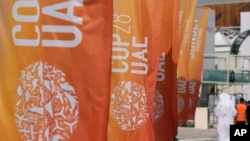The COP28, or Conference of Parties, begins on Thursday in Dubai and is meant to last 13 days, but climate negotiations often run past their official deadlines as countries haggle until the last minute to find a consensus.
COPs are the formal meetings of the United Nations Framework Convention on Climate Change, UNFCCC, tasked with addressing human-caused global warming.
The UNFCCC organizes nations into five groups: African states, Asian states, Eastern Europe, Latin America and the Caribbean, Western Europe and "Other States", which include Australia, Canada, Iceland, New Zealand, Norway, Switzerland and the United States.
It also divides countries in three categories: developed countries, developed countries with special financial responsibilities and developing nations.
But various informal and formal clubs, which sometimes mix together wealthy and poor countries, have emerged over the years, with some nations working in more than one bloc.
This year's COP comes against the backdrop of the Israel-Hamas war and Russia's ongoing war in Ukraine, which have raised global tensions.
Climate negotiations were for a long time believed to be "immune" to world events as if they were "so important that they were protected from the frictions of current events", said Francois Gemenne, a political scientist and member of the Intergovernmental Panel on Climate Change, IPCC.
"This is no longer the case," he told AFP.
Countries lumped together can also have diverging positions on climate issues.
"Developing countries are rarely unified," said Jennifer Allan of the International Institute for Sustainable Development.
"The fact that they've remained unified on loss and damage, for instance, that's rare," Allan said, referring to last year's historic agreement to set up a fund for poor nations devastated by climate impacts.
Here is a list of the main negotiating groups at the COP:
G77 (and China)
This group of 77 countries was founded in 1964 and has since grown to 134 countries, often aligned with China.
It is the largest negotiating bloc and functions throughout the UN system, beyond the UNFCCC.
Its party chair rotates annually, with Cuba currently at the helm for the first time.
Least Developed Countries (LDCs)
The LCD group consists of 46 countries and brings together — as its name suggests — the world's poorest nations. It is currently chaired by Nepal.
The topics at stake in the COP negotiations sometime result in the LDC taking a different viewpoint from the G77.
Climate Vulnerable Forum (CVF)
CVF brings together 58 countries with a combined population of 1.5 billion people that are highly vulnerable to the impacts of global warming.
Founded in 2009, it is currently chaired by Ghana.
Small Island Developing States (SIDS)
SIDS is a coalition founded in 1990 of 40 low-lying islands or archipelagos threatened by rising sea levels. It is chaired by Samoa.
Despite its small size, it is widely recognized for its vocal role in the climate talks.
European Union (EU)
The EU bloc groups the 27 member states to agree on one common negotiating position.
The presidency of the European Council is held by Spain until the end of the year.
Umbrella Group
This group formed following the 1997 adoption of the Kyoto Protocol and is made up of a number of developed nations: Australia, Britain, Canada, the United States, Iceland, Israel, Japan, Kazakhstan, New Zealand, Norway and Ukraine.
It is generally opposed to the G77 or the LCDs.
BASIC
The BASIC bloc groups four large newly industrialized nations: Brazil, South Africa, India and China.
It came together in 2009 during COP15 in Copenhagen.
Independent Alliance of Latin America and the Caribbean (AILAC)
AILAC was established as a formal negotiating group in 2012 and represents a coordinated position for the countries of the North and South, including Colombia, Costa Rica, Guatemala (its current chair), Honduras, Panama, Paraguay, Peru and Chile.
Various Blocs to Negotiate at COP28 Climate Conference

PARIS - The UN's climate negotiations involve a diplomatic tug of war between eclectic blocs of countries that group together to push common interests even though geopolitics might divide them.











Forum